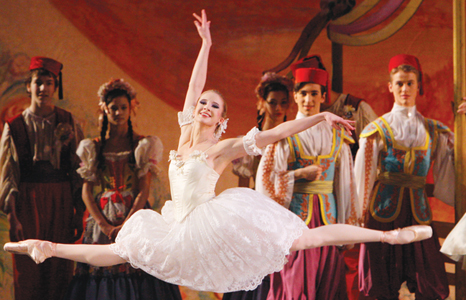Photographs by Anthony Carboni
Whatever Sheila Stanton DePaola does and wherever she goes, she is sure to step lively. That’s because this music teacher by day is also an avocational step dancer.
Sheila, who teaches chorus and general music to prekindergartners through eighth-graders at the Pocantico Hills Central School in Sleepy Hollow, performs and competes with the White Plains-based O’Rourke Irish Dancers. Sure, they’re booked come February and March. But don’t even think of inviting Sheila over during Thanksgiving weekend. You’ll find her and supportive hubby, Stephen DePaola, (“He’s got a bit of Irish in him,” she says) at the Mid-Atlantic Oireachtas, a competition featuring thousands of step dancers who converge on Philadelphia to perform.
There you’ll see dances involving quick, intricate footwork – either solos, for which the dancers wear hard shoes with fiberglass tips, similar to tap shoes; or céilís (“KAY lees”), group dances for which the dancers wear gillies, soft shoes similar to ballet slippers. It’s only in the céilís, Sheila says, that the dancers raise their arms in a somewhat stiff arch. Unlike other kinds of folk dancing – such as flamenco, which is characterized by sinuous arm movements and a supple back – step dancing is all about the legs driving into the ground, with the arms at the sides.
There are any number of reasons for this.
“The stories I’ve heard,” Sheila says, “is that the British wouldn’t allow the Irish to dance. The top half of the doors to the houses would be open. When the British looked inside, they wouldn’t know the Irish were dancing, because they didn’t see any arm movements.”
Other theories suggest that the same doors were actually used for a small dance floor that didn’t allow for much room and thus arm movement or that the stiffened arms actually called greater attention to the flashing legwork in competition. Whatever the rationale, the combination of fleet feet and infectious music has proved to be a bewitching one, igniting a craze in this country in the 1990s with “Riverdance,” starring Irish dancing champions Jean Butler and Michael Flatley, and then “Lord of the Dance,” which Flatley created after leaving “Riverdance.”
Sheila didn’t need any Lord of the Dance for inspiration.
“I certainly grew up with the love of Irish music and dance,” she says of her Yorktown upbringing.
On Sunday afternoons, her father made her listen to the Irish music program on WFUV-90.7 FM, Fordham University’s radio station. Little did he know that he was nurturing a step dancer. But though she studied the art in a local school, music had the professional claim on her heart. It wasn’t until a parent of a Pocantico Hills school student suggested she get back into dancing that Sheila took the necessary step.
Now she practices up to 90 minutes a week with the O’Rourke Irish Dancers and one hour, two to three times a week, on her own. Because she’s tall, 5 feet 10 inches, she’s “always the gent” in the céilís, which have prescribed partnering and patterns that echo quadrilles.
That lofty height comes with a 9½-10 shoe size, which translates into a 7-7 ½ step dance shoe. Whether Sheila’s in pumps, boots, gillies or running shoes (she’s also a half-marathoner), the Purdys resident admits, “I do not have pretty feet.” That’s because step dancing relies on a lot of toe work, as in ballet. So the muscles under her feet are more developed than those atop, causing the tootsies to curl. Sheila keeps them in shape with regular pedicures and reflexology massages.
What really keeps those toes a-tapping, though, is the tune within. Regardless of the kind of dance, there are only two types of dancers – those who visualize patterns and steps, copying both until they are ingrained in the body, and those who respond to the music, particularly its rhythms. Sheila is the latter.
“I think of it differently,” she says. “I have the counts and beats in my head.”
Just as her musicality has enhanced her step dancing, so her step dancing has influenced her teaching career. Sheila has been known to bring in a bodhrán (“boron”), an Irish drum, and have the students mimic its sounds and rhythms by tapping pencils on empty pizza cartons.
“It’s fun,” she says of the Gaelic-flavored music lessons. “And it makes for some interesting marches in class.”
For more, visit orourkeirishdancers.com.
Join the conversation: #wagstepdancing




